Chapter 1
Introduction and Background
Terms of reference
1.1
On
17 June 2009, the Senate referred the following matters to the Senate Standing Education,
Employment and Workplace Relations (EEWR) References Committee for inquiry and
report by 16 November 2009 (this was subsequently extended to 25 November
2009):
-
the roles and responsibilities of
education providers, migration and education agents, state and federal
governments, and relevant departments and embassies, in ensuring the quality
and adequacy in information, advice, service delivery and support, with
particular reference to:
-
student safety,
-
adequate and
affordable accommodation,
-
social
inclusion,
-
student visa
requirements,
-
adequate
international student supports and advocacy,
-
employment
rights and protections from exploitation, and
-
appropriate
pathways to permanency;
-
the identification of quality benchmarks
and controls for service, advice and support for international students
studying at an Australian education institution; and
-
any other related matters.
Conduct of the inquiry
1.2
Notice of the inquiry was posted on the committee's website and
advertised in The Australian newspaper, calling for submissions by 14
August 2009. The committee also directly contacted a number of interested
parties, organisations and individuals to notify them of the inquiry and to
invite submissions. 124 submissions were received as listed in Appendix
1.
1.3
The committee conducted public hearings in Melbourne on 1 September,
Sydney on 2 September and Canberra on 18 September 2009. Witnesses who appeared
before the committee are listed at Appendix 2.
1.4
Copies of the Hansard transcript from the hearings are tabled for the
information of the Senate. They can be accessed on the internet at https://www.aph.gov.au/hansard.
References in this report to the committee Hansard are to the proof Hansard;
page numbers may vary between the proof and the official Hansard transcript.
1.5
The committee thanks all those who contributed to the inquiry,
particularly the students who took the time to inform the committee's
considerations with their own experiences.
Background to the inquiry
1.6
This inquiry was initiated following a series of attacks upon Indian
students in Melbourne and Sydney (the incidents).
1.7
These incidents damaged Australia's reputation as a safe destination for
overseas students. The reporting of the incidents made headlines in the Indian
press and were met with a rapid response by relevant authorities in Australia.
1.8
Following these incidents, delegations from Australia went to India to
assure prospective students and their families of the measures in place in
Australia to ensure the safety of international students.
1.9
As the incidents were investigated, the focus broadened to consider the
quality of education being marketed to foreign students. What emerged were
frustrations experienced by foreign students in their dealings with the
educational institutions in which they were enrolled.
Complementary inquiries
Education Services for Overseas
Students Amendment (Re-registration of Providers and other Measures) Bill 2009
1.10
This inquiry into the welfare of international students overlapped in
time and subject matter with the EEWR Legislation Committee's inquiry into the
Education Services for Overseas Students Amendment (Re-registration of
Providers and other Measures) Bill 2009 (the ESOS Bill).
1.11
On
20 August 2009, the Senate referred the ESOS Bill 2009 for inquiry and report. The
ESOS Bill amends the Education Services for Overseas Students Act 2000
to improve processes ensuring the accountability of international education and
training services providers. This includes the re-registration of all
institutions currently on the Commonwealth Register of Institutions and Courses
for Overseas Students (CRICOS) by 31 December 2010. It also introduces
provisions for two new registration criteria and requires the publication by
providers of the names of education agents who represent them and promote their
education services. The committee reported on 16 October 2009.[1]
The Baird review
1.12
The Hon Bruce
Baird is conducting a review into international education in Australia. Mr Baird will review the Education Services for
Overseas Students (ESOS) Act and report back to the government with changes
designed to ensure Australia continues to offer world-class quality
international education in this challenging and changing environment.
1.13
The Review will consider the need for enhancements to the ESOS
legal framework in four key areas: supporting the interests of students; delivering quality as the
cornerstone of Australian education; effective regulation; and sustainability
of the international education sector. An interim report from the Review will
be presented for consideration by the Council of Australian Governments (COAG)
in November 2009, with a final report expected in early 2010.[2]
Complementary measures
1.14
The amendments to the ESOS Act and the review are but two of a series of
measures to ensure that Australia continues to offer world-class quality
international education. Complementary initiatives to enhance Australia’s
ability to deliver quality education services to overseas students include the following:
-
the establishment of the International Student Taskforce in the Department
of Education, Employment and Workplace Relations (DEEWR) to develop strategies
to support the wellbeing of students and provide secretariat services for the
review of the ESOS Act;
-
from 2010 the Tertiary Education Quality and Standards Agency
(TEQSA) will be established which will oversee the new framework for quality
assurance and regulation for universities and private providers of higher
education;[3]
-
COAG has agreed to develop further reforms to the VET sector
including models for a national regulatory body for VET and a model could be
TEQSA;
-
the Study in Australia 2010 initiatives to promote
Australia's international education, such as on-line training of education
agents overseas;
-
establishment of a telephone hotline in DEEWR for students to
raise their concerns anonymously;
-
an international student roundtable was held in Canberra on 14-15
September 2009; and
-
the development of the National International Student Strategy
under COAG to improve the quality of education and student well-being for the
2010 academic year.[4]
The education sector and the economy
1.15
The number of foreign students studying in Australia has risen since the
government deregulated the tertiary education sector in 1986.[5]
In 2008, the international education sector was worth $15.5 billion, up 23.4 per
cent from 2007. It remains the third largest export behind coal ($46.4
billion) and iron ore ($30.2 billion) and the largest services export industry
as shown in the chart below.
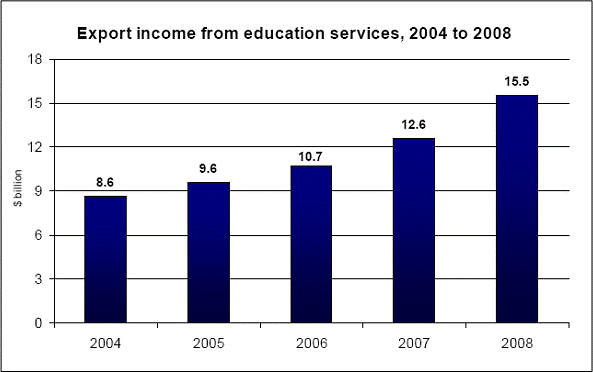
Source: Australian Education
International, Research Snapshot, Export Income to Australia from Education
Services in 2008, June 2009.
1.16
While all states have benefited from this growth, the income received is
particularly significant for Victoria and New South Wales as shown in the map
below.
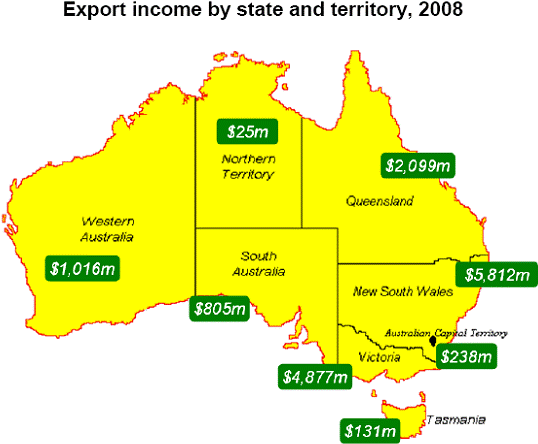
Source: Australian Education
International, Research Snapshot, Export Income to Australia from Education
Services in 2008, June 2009.
Composition of the international education
sector
1.17
The international education sector is comprised of:
-
universities and private higher education providers;
-
vocational education and training (VET) providers;
-
English language intensive courses for overseas students
(ELICOS); and
-
secondary school programs.
1.18
Private providers offering VET courses include employer training
organisations or industry associations as well as registered training
organisations such as business colleges.
1.19
Public VET providers include government-funded technical and further
education (TAFE) colleges, agricultural colleges and some higher education
institutions.
Enrolments
1.20
There were more than 500 000 enrolments of international students in
2008-09.[6]
However, there have been significant changes in the characteristics of
enrolments over the past few years.
Higher education
1.21
International students in higher education have grown from 21, 000 in
1989 to over 250 000 in 2007. Australia has one-tenth of the world market for
higher education, and is the third most popular English-speaking destination
behind the United States and the UK.[7]
Victoria and New South Wales have the highest numbers of international students
in higher education as can be seen in the table below.
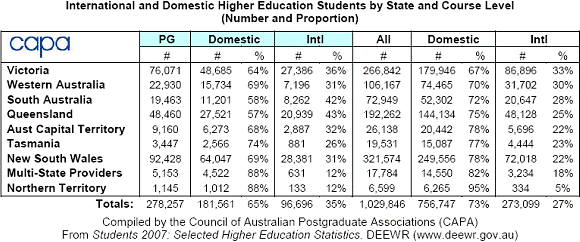
Source: CAPA, Submission 53,
p. 10.
1.22
Research has shown that the demand for international higher education
will continue,[8]
although it is unclear to what extent the global financial crisis may affect
such demand. The committee notes the availability of higher education in Asia
is growing rapidly. This is a competitive alternative to studying in Australia
because students are able to learn English while gaining a qualification for
far less cost.[9]
1.23
While the figures reflect Australia's success in attracting
international students, international student fees now comprise a significant
proportion of overall university income. Statistics show that the average
proportion of total revenue in higher education derived from overseas student
fees is 15 per cent. See table below.
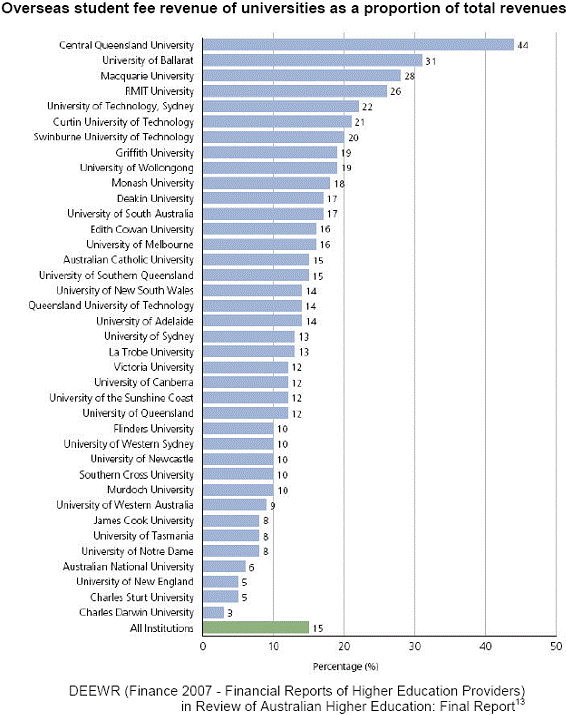
Source: CAPA, Submission 53,
p. 15.
1.24
Dr Withers explained funding changes for universities and the growth in
numbers of international students:
...We have a regime that is not fully rational in that we do
not fund domestic undergraduate full-fee students the full cost of their
education through Commonwealth payment. It is about 80 per cent of the full
cost of delivering services to domestic undergraduates through the Commonwealth
payments. In one sense I can make that as a bipartisan statement because it was
Paul Keating who began that problem and it continued under the coalition,
mainly through inadequate indexation of Commonwealth payments for domestic
undergraduates. The natural incentive for universities to do the right thing by
their undergraduates is to find other sources of money when the Commonwealth is
not adequately providing for them. So what we saw over the past 15 years was a
massive growth of postgraduate coursework masters of both domestic and
international students and international undergraduate students and, for a
short period, domestic full-fee students. The universities play a funny
pea-and-thimble trick with that and their research, because, as is also
evidently clear, research costs of Commonwealth funded grants are not full
cost. That is, if you receive an ARC or an NHMRC grant, it covers the costs of
some associated costs, but the principal investigators cost, the laboratory
costs and so on are covered in other ways. So universities go around trying to
find areas where they can generate surpluses that will cross-subsidise the
areas that are not fully funded. The growth of international students has to be
seen as partly driven by that. That is by the university managers...at the
university strategic level, yes, there is some revenue motivation—not profit
motivation, since universities are not-for-profit institutions—to deal with
inadequacies in some of the funding settings that universities have imposed
upon them.[10]
1.25
Dr Withers also described the effect of voluntary student unionism:
We feel it has cost the student experience substantially. The
proposals for a student amenities fee, we feel, would help the student
experience substantially, particularly in the core areas of health, sports,
employment advice and accommodation advice. We know that those services are
particularly used by students more away from existing living networks. Ones who
are away from those networks draw on them more.[11]
Student cohort
1.26
Over 80 per cent of international students in higher education in 2007
were from Asia including 21 per cent from China. In this same year, over half
of all international students studied in the management and commerce disciplines,
with 67 per cent of the Chinese cohort of 58 588 students undertaking
degrees in these subject areas. Additionally, 59 per cent of all international
students were undergraduate students and a further 28 per cent were studying
coursework masters degrees. Only 3.6 per cent were undertaking research higher
degrees.[12]
Vocational education and training
sector
1.27
The committee heard evidence that the higher education sector led the
VET sector in 2008, with more than eight billion dollars in export earnings
compared to less than 3.5 billion dollars.[13]
However, growth patterns and enrolment figures present a changing picture.
1.28
Most of the growth in international education has come from the VET
sector. The number of VET enrolments has more than tripled since 2002. It now
accounts for the largest proportion of total enrolments (37 per cent for the
six-month period to June 2009 compared to 36 per cent for the higher education
sector).[14]
See table below.
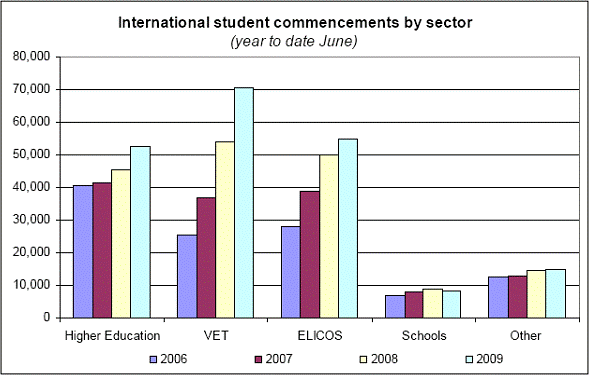
1.29
International student enrolments in private VET colleges increased 60
per cent, from 5 911 in 2005 to 26 667 in 2008.[15]
1.30
The Australian Federation of International Students in its evidence to
the committee indicated more substantial growth of almost 227 per cent between
2002 and 2008.[16]
1.31
While growth in the number of international students entering the VET
sector has been seen in all states, Victoria, New South Wales and Queensland
have shown the highest rates of growth. However, at 92 per cent, New South
Wales has the highest rate of enrolments by international students with private
VET providers.[17]
1.32
The growth in enrolments has been accompanied by an increase in the
number of private VET providers from 363 in 2004 to 464 in 2008.[18]
DEEWR in its evidence said that:
[o]verall, the number of providers changed only slightly from
1070 in 2004 to 1135 in 2008. Larger providers (those with more than 100
enrolments) increased in number from 260 in 2004 to 392 in 2008 while small
providers (those with 99 or fewer enrolments) fell from 810 to 743 during this period.
The number of private VET providers with fewer than 100 enrolments remained
almost constant during this period, increasing from 283 to 287 while the number
with 100 or more enrolments grew from 80 to 177.[19]
1.33
The most popular field of study in VET courses was management and
commerce, followed by 'food, hospitality and personal services'. The Australian
Education Union gave evidence to the committee that the three most popular
fields of study represented 4 out of 5, or 80 per cent, of all international
VET enrolments.[20]
1.34
Similar to the higher education sector, there is a concentration of
students in particular course types within the VET sector. Such enrolment
patterns may contribute to the isolation of international students, adversely
affecting their educational, cultural and general experiences. Such isolation
reduces the opportunities available to Australian students and communities for
cross-cultural exchanges.
1.35
TAFE Directors Australia, in its evidence to the committee, said that
this swell in numbers over the past five to ten years has largely resulted from
linking permanent residency and study.[21]
1.36
When asked about the causes of the growth in the numbers of RTOs,
DEEWR's evidence was:
There are obviously a range of opinions on this subject. The
immediate cause of having courses available and places for people to fill is
that the states have registered more training organisations. Those training
organisations have filled more places and there have been students available to
fill those places.[22]
Committee view
1.37
The committee notes the reluctance of DEEWR to comment on the
performance of state agencies in their administration of registration
functions. This is understandable in view of their need to work harmoniously
with state agencies. The committee recognises that a key focus of this report
is the allegations of exploitation of students in the VET sector.[23]
This is discussed in more detail in later chapters.
Foreign students in schools
1.38
The enrolment of foreign students in schools presents no problems of the
kind reported in the private VET sector. Schools are strictly regulated and
offer only a limited number of places to foreign students.
1.39
The Independent Schools Council of Australia (ISCA) gave evidence to the
committee that currently there are over 23 000 overseas students in Australian
schools and, of these, around 60 percent are enrolled in non-government
schools. The numbers have remained relatively steady for some years. There are
overseas students enrolled at nearly 400 independent schools, representing less
than half the total number of schools in the sector. Numbers vary from one to
over 400 with a median number of 11 students. ISCA noted the duty of care
towards students as they deal almost exclusively with children under the age of
18 and this includes approving the accommodation and welfare arrangements and
the provision of support services.[24]
Navigation: Previous Page | Contents | Next Page